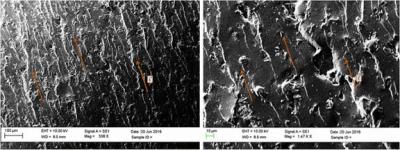Researchers from The University of Manchester have conducted a study that presents a review of the three steps of manufacturing graphene/epoxy nano-composites. The possible pre-treatments of nanoparticles before dispersion are introduced, and their influence on the final nanocomposite properties discussed.
 SEM images of fracture surface of aligned GNP based epoxy composite
SEM images of fracture surface of aligned GNP based epoxy composite
The study stresses interesting results, among which are improvements in various characteristics via the use of GNPs. For instance, an improvement of the thermal diffusivity of 220% was seen when compared to a non-oriented GNP epoxy sample. The work demonstrates how the addition of functionalized graphene platelets to an epoxy resin will allow it to act as electrical and thermal conductor rather than as insulator. The mechanical properties of functionalized GNP/epoxy composites show improvement of the interfacial bond.
This work confirms that the number of parameters and processes available to manufacture advanced multifunctional graphene/epoxy nanocomposites presents many challenges as well as potential for future applications.
The post dispersion treatment shows impressive improvements in electrical and thermal properties of the composite (up to 220% increase in thermal diffusivity at 5 wt%), and allows anisotropic properties to be obtained, making these materials suitable for specific applications such as de-icing or lightning strike protection if applied to aircraft skin. Raman spectroscopy and SEM confirmed the formation of chain structures along the direction of the applied field. However, this requires use of a strong electrical or magnetic field which can add to the production cost.
i-Composites lab is a group within the school of materials at the university of Manchester, primarily involved in developing novel advanced multi-functional composite materials for smart structures applications (aerospace, naval, civil engineering, and energy).



